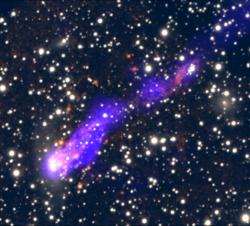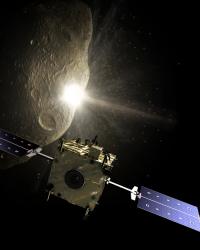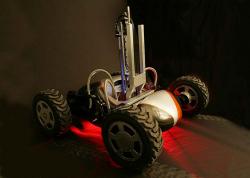In late afternoon, the wispy clouds part. For the first time I discern the distant domes, tiny and white, on the peak of blue-grey Mauna Kea, but a heavy cloud hovers above. Dr. Hammel tells me that once the sun sets, this cloud will cool, sink and wrap the telescopes in its fog, unless – there's a small possibility – the cloud sinks all the way beneath the summit, down below the telescopes. Despite the bleak predictions in all the weather forecasts for tonight, I begin to hope that we'll finally get some data.
I am at Keck Observatory in Hawaii for the Uranian astronomer's equivalent of Halley's Comet: ring plane crossing. It is the last night of the observing run for the team greeted by the Keck Observatory staff as "the ring plane crossing dudes": Dr. Imke de Pater of UC Berkeley, Dr. Heidi Hammel of the Space Science Institute, Dr. Mark Showalter of the SETI Institute, and me, Dr. Showalter's summer research student, an eager undergraduate who has just finished her sophomore year at Wellesley College. Earlier this week, as my plane took off from Boston, I watched the plane's shadow on the harbor shrink as we ascended. The airplane turned and as the wing on my side tilted toward the water, the plane's shadow collapsed into a line. This is just what I hope to see in Hawaii, the once-in-forty-two-years geometry of the Uranian ring plane crossing period: as Earth crosses the plane of the Uranian rings, we view the rings edge-on.
Ring plane crossing is a unique time for astronomers to study both the Uranian ring structure and to detect faint moons usually obscured by the glare of the rings. The three nights we're observing, September 6th-8th, are also Opposition, when the Earth lies on a straight line between the Sun and Uranus, a particularly good geometry for viewing faint moons. Small, faint, inner Uranian moons are the subject of my research tonight, as I've spent the summer studying their chaotic motions. Their trajectories, though not random, are so sensitive to initial conditions as to be unpredictable. But the opportunity to study the chaotic Uranian satellite system with the 10-meter Keck II telescope had been jeopardized by the paradigm system of chaos theory, Earth weather. Dr. Showalter had originally invited me to observe with him in August, but that trip was canceled at the last minute due to an approaching hurricane. Now, during this observing run, we have obtained hardly any data because of fog and humidity. Everyone has begun teasing Dr. Showalter because there's always bad weather when he's on the island. But, we have one more night to attempt an observation of Uranus during ring plane crossing at Opposition.
As I anticipate observing Uranus for the first time, I remembered the time I initially observed a planet with moons and rings. At the Whitin Observatory at Wellesley College, on a crisp, clear New England November night, I located the lever in the rare red light and pushed it to rotate the creaking dome until Saturn was in the slit. Using the system of ropes attached to its brass body, I positioned the fifteen foot long, fifteen-thousand pound, one-hundred-and-fifty year old refracting telescope, scrambled up a wheeled-staircase, and pressed my eye to the ice-cold eye piece. As I turned the knob to focus the lens, Saturn sharpened into view, its tiny moons and rings perfect, exquisite and almost unbelievable.
Two years later, I am observing the moons and rings of Uranus in an air conditioned computer lab under the glare of white fluorescent lights. Dr. Hammel is talking to the telescope operator at the summit through a video link, Dr. de Pater is typing commands into the computer that controls an infrared CCD camera attached to the telescope, and Dr. Showalter is optimistically monitoring the output of a humidity measurement instrument at the summit. As we were preparing that afternoon, a staff member wheeled in a new, modern set of ergonomic leather chairs intended to make the long hours spent observing more comfortable. But the most amazing modern marvel at Keck Observatory is the adaptive optics system.
I was shocked when Dr. Showalter told me, "Keck beats out Hubble on a lot of things now." How can observations from Earth even with 10 meter telescope in the thin, dry atmosphere at 14,000 feet possibly be better than observations with the Hubble Space Telescope? When light enters the atmosphere, it is scattered by our turbulent, chaotic atmosphere, and we see a blurred and distorted image; this is why the Hubble Space Telescope, which orbits above the atmosphere, takes such sharp and detailed images. But, for about five years now, light entering the Keck telescopes has been corrected for atmospheric distortion by an adaptive optics system. We cannot predict how chaotic atmospheric turbulence will distort the light, but, with the adaptive optics system, we can measure and correct for the distortion a thousand times a second. Unfortunately, adaptive optics cannot fix bad weather. As we run our preliminary tests the humidity is changing rapidly, and, when the interesting feature on a test image is blurred out on the real exposure, Dr. Hammel suggests with a sigh, "We could draw it, as astronomers did 200 years ago."
Around midnight on our last night, as the humidity drops and the air stabilizes, we finally begin to get some excellent data. Soon the "seeing" (a measure of the image's blurriness) is down to 0.39 arc seconds, the best possible seeing on Earth. "You can never trust the weather predictions," says Dr. de Pater, and I smile to myself because unpredictable weather has given me a chance to observe Uranus' unpredictable moons. Thirty years ago Uranus' rings were discovered during observations from an airplane by detecting a dip in starlight when a star passed behind them; tonight we resolve the different ring bands edge-on from Earth. This night we also observed volcanoes on Jupiter's moon Io; and the moon of asteroid (45) Eugenia, which was discovered in 1999 using the adaptive optics system.
The weather has been perfect, so Dr. Showalter is formally absolved of causing Hurricane Flossie in August. Then the night is over, and as the sun rises I stand outside the observing station looking to the south and see the peak of Mauna Kea is once again obscured by clouds. Suddenly I make the connection between all the chaotic systems that I've struggled to understand tonight – the weather, the atmospheric turbulence, the Uranian moon motions – and realize that this experience wasn't once-in-forty-two-years but once-in-an-eon. Valentine in Tom Stoppard's Arcadia marvels that, "A door like this has cracked open five or six times since we got up on our hind legs." Only recently have we developed the numerical methods and fast computers necessary to understand chaotic systems, systems where, as Valentine says, "the unpredictable and the predetermined unfold together." Not only weather, moons, and atmospheric turbulence but most systems in the real world are chaotic: population growth, water dripping from a faucet, the stock market, traffic, the human heart. As the Earth's orbit passes through the Uranian ring plane, we on Earth are entering a new mathematical and scientific era.
My travel expenses were generously covered by Wellesley College Astronomy Department's Wilson-Birney Fund, Massachusetts Space Grant and the National Science Foundation, which also funded my summer research at SETI












